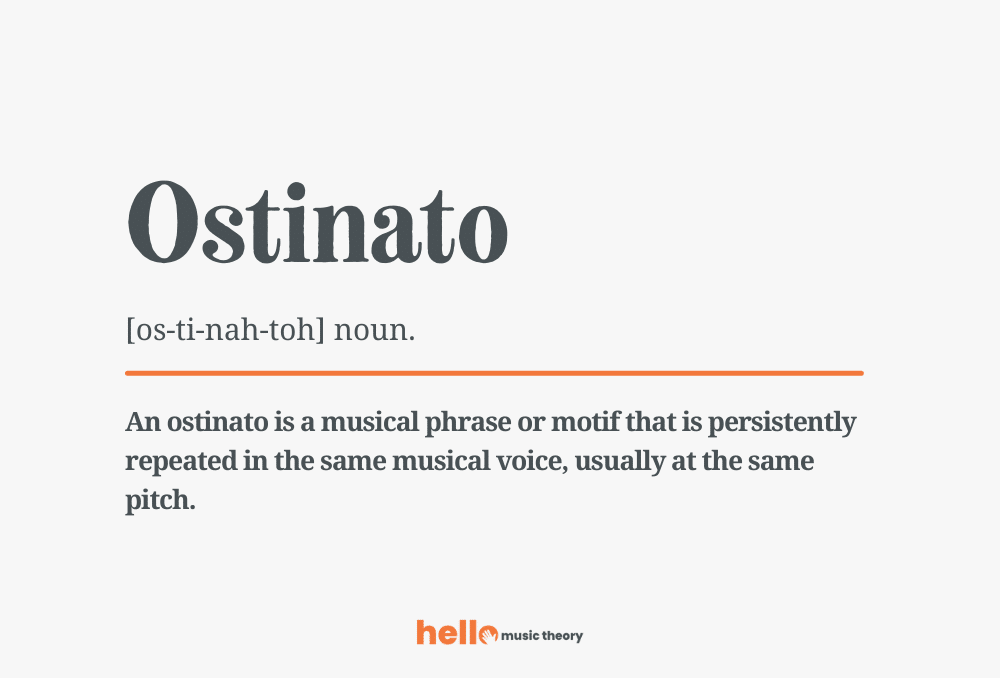There are a lot of Italian, French, and German terms that are not used anywhere else in English except for music theory. The word Ostinato is one of these terms and is often misunderstood as to exactly what it means.
In this article, we’ll look at exactly what an ostinato is in music, and how to recognize one as well as compose one.
Definition of Ostinato

The word ostinato is an Italian term that means stubborn or obstinate, or something that remains unchanged.
In music, we use it to define a short motif or phrase that remains unchanged throughout a piece, consistently repeating over and over often in the same musical voice and in the same pitch and register.
The plural of the term ostinato is ostinati, and a single piece of music can have multiple ostinati played within it at the same time.
The repeating motif that makes up the ostinato might be a rhythmic idea a part of a harmonic progression, or an entire melody.
As long as it repeats pretty much exactly the whole time, it can be considered an ostinato.
It might be able to change if the key or harmony changes, but often, they stay the exact same.
In the example below, the bottom voice plays an ostinato pattern of repeated C – D – E eighth notes while the upper voice plays the melody.
History of the Ostinato
Ostinati first appeared in Western music, most likely medieval music era, sometime in the 13th century.
For example, the famous English canon song “Sumer is Icumen in” features an ostinato in the lower parts under the main melody:
Another good example is ‘Resvelons Nous’ by the renaissance period composer Guillaume Dufay, a 15th century motet.
The string ostinato at the beginning continues throughout the piece, while the melody changed over top.
This could be considered an example of Ground Bass, or Basso Ostinato.
This is when the bass line of a piece stays the same, or even the harmonic progression built from the bass, but the melody changes or goes through variations above it.
A famous example of the Basso Ostinato is Pachelbel’s “Canon in D.”
Listen to the left hand, each progression follows the same bass pattern.
Here is the bass ostinato for “Canon in D,” which repeats ad infinitum throughout the whole piece:
Riff and Vamp
In contemporary music, like pop, rock, or jazz music, you might have heard the terms riff and vamp used when referring to certain parts of a song.
These terms are both similar in concept to ostinato, but they are a bit different.
A Riff is a short, repeated musical phrase.
It could be rhythmic, melodic, or harmonic, but it is typically repeated throughout a song.
It can also be called a hook, and is usually the most recognizable musical feature in a song.
Many riffs, especially the most famous ones, are melodic in nature, so riffs are more often thought of as short melody fragments.
For instance, one of the most popular guitar riffs ever is “Iron Man” by Black Sabbath:
What separates a riff from an ostinato is that usually a riff is not repeated throughout the entire song.
Often it is only used for the verses of a song, rather than the chorus, or vice versa.
It is more of a decorative aspect than a structural one.
A Vamp, on the other hand, is more closely related to harmonic, accompanying texture than melody.
Vamps are usually found in jazz, blues, or funk music, upon which a melody is either improvised or composed.
Vamps are often harmonically sparse, typically consisting of a single chord held for a long time, or maybe a slow progression between two long-held chords.
Many vamps often come at the end or solo section of a song, and can be the basis for a “jam” section.
A song that uses a vamp style for the entire length of the song, and thus it could be considered an ostinato, and a riff, as well, is “Loser” by Beck.
Ostinato Use in Minimalism and Film Music
The most common genre of music you would find ostinati being used is minimalism, and by extension, film music, because the majority of contemporary film music uses the same structural and stylistic properties as minimalist music.
Minimalist music is based on repetition and ostinato structure.
For example, this piece by Philip Glass, titled “Mad Rush” uses multiple ostinati throughout, for both the harmonic and melodic parts:
The left hand harmonies use the A – C minor 3rd eighth-note ostinato pattern throughout, and the right hand melody is essentially just a triplet A-C set an octave above.
In film music, ostinati are used to create a sense of rhythm and direction, to develop a connection between two different locations or times via cross cutting, and to keep the audience’s attention throughout a longer scene.
All three of these points are on display in this scene from The Social Network, using the track “In Motion” by Trent Reznor and Atticus Ross:
Although the entire cue is built with multiple ostinato layers on top of each other, the main one is this sixteenth-note bass pulse.
Another film that uses an ostinato throughout is the film Sicario, in which composer Johann Johannsson uses a drum rhythm as an ostinato throughout, as heard here in the cue “The Beast.”
The drum beat can really be heard best after the 0:40 second mark, but it steadily crescendos throughout the cue.
In Summary
Ostinato patterns have been around for centuries and are still used in many types of music.
Whether you’re a musician or not, understanding the basics of ostinatos can help you appreciate some of your favorite songs on an entirely new level!
It is often a structural device that acts as a musical backdrop or constant repeating figure that then other melodies, harmonies, or rhythms can be played on top of.
Thank you for reading this blog post and we hope that you found it informative and interesting.



